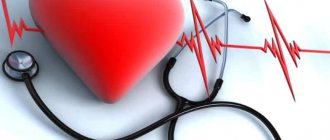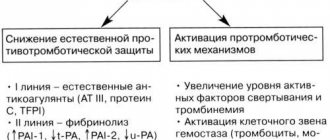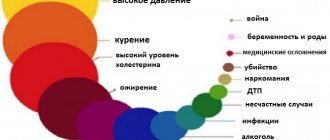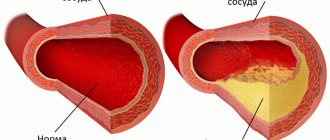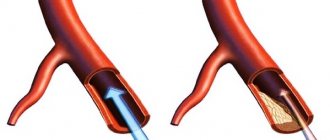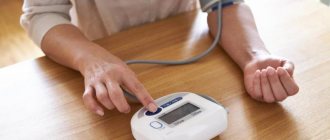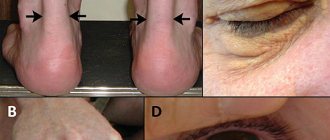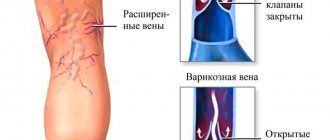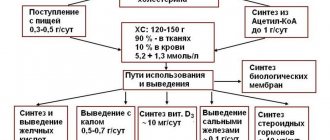What is the Score scale and what is it used for?
The Score scale began to measure absolute cardiovascular risk in 2003. The decision to use this technique was made after 12 basic studies were carried out in Western European countries aimed at creating a unified system for predicting potential consequences for the heart and blood vessels.
The scientific project involved 205,178 patients of different ages, gender, and also having different indicators of blood tests and the functional state of internal organs.
Using research data, doctors were able to create a universal scale that is used to make a high-quality and objective forecast for the development of the risk of possible diseases of the cardiovascular system, as well as the occurrence of death in adult men and women.
What factors are taken into account when calculating, formula
The absolute cardiovascular risk according to the Score scale is calculated by applying a formula that consists of a set of coefficients, and the prognosis for the patient’s survival over the next 10 years is compiled in several stages.
The following factors must also be taken into account:
- gender;
- does the patient already have acquired pathologies of the cardiovascular system;
- upper blood pressure;
- biological age;
- cholesterol concentration in human blood;
- hereditary predisposition to the development of heart and blood vessel diseases;
- the presence or absence of diabetes mellitus type 1 or 2;
- addiction to smoking.
The presence of one or another factor listed in the list above affects the final results of assessing the risk of death over the next 10 years. Making a survival prognosis exclusively affects the functional state of the patient’s cardiovascular system without taking into account the likelihood of death from chronic diseases of other organs.
What complications can there be with CVS?
Cardiovascular complications in hypertension are a reality for every person with a history of this disease. Changes may occur in the following areas:
- Hearts. It expands the left ventricle and deteriorates the elastic properties of the myocardium. As the disease progresses, LV function becomes impaired, which can result in heart failure if not treated promptly. In addition, if large vessels are damaged, there is a high probability of developing a heart attack, which can be fatal.
- Urinary organs. Blood circulation actively occurs in the kidneys, which is disrupted during hypertension. This may result in chronic renal failure.
- Brain. Hypertension leads to poor circulation throughout the body, including the brain. As a result, he experiences a lack of nutrition and oxygen, which is fraught with memory deterioration, decreased attention, and the development of diseases accompanied by a decrease in intellectual capabilities. Often, blood clots form in blood vessels against the background of high blood pressure, which can lead to impaired blood flow and the development of a stroke.
- Visual organs. Against the background of constantly elevated blood pressure, a person’s visual acuity decreases. In addition to everything, he will constantly feel a feeling of pressure in the eye area, which will manifest itself as drowsiness and decreased performance.
With grade 3 and 4 hypertension, the risk of complications increases several times. All pathologies are dangerous and lead to a shortening of the patient’s life, with a violation of its quality. All this can be prevented only by timely treatment, including medications, diet, etc.
Odds
The tables present the coefficients that are used to assess the potential risk of death from cardiovascular diseases, taking into account the Score methodology.
Table 1:
| Main risk factors for death | Coronary heart diseases | Non-coronary diseases of the cardiovascular system |
| Use of tobacco products | 0,71 | 0,63 |
| Cholesterol (unit mmol/l) | 0,24 | 0,02 |
| Systolic blood pressure indicator | 0,018 | 0,022 |
Table 2:
| Coronary heart diseases | Non-coronary diseases of the cardiovascular system | ||||
| A | R | A | R | ||
| Low level | Male | -22,1 | 4,71 | -26,7 | 5,64 |
| Female | -29,8 | 6,36 | -31,0 | 6,62 | |
| High level | Male | -29,8 | 4,62 | -25,7 | 5,47 |
| Female | -29,8 | 6,23 | -30,0 | 6,42 | |
Based on these coefficients, a formula is drawn up with further complex and step-by-step calculations, allowing one to obtain the final result in the form of the potential probability that over the next 10 years a particular person will die from heart or blood vessel diseases.
In this case, the onset of death can occur suddenly, or occur due to prolonged coronary heart disease.
Calculation stages
Absolute cardiovascular risk according to the Score scale is calculated in several steps, each of which represents the acquisition of new information data necessary to move to the next stage of this analytics.
Step 1
At this stage, the chances of survival of the individual being studied are assessed. To do this, use the calculation method described below.
So (person's age) = exp{-(exp(a)) (age indicator - 20)р}
So (person's age - 10) = exp{-(exp(a)) (age indicator - 10)р}
In this case, the component So is an indicator of a person’s potential survival under the influence of a particular cardiovascular disease.
Step 2
The next stage of analyzing the risk of death from pathologies of the heart and blood vessels, which are determined using the Score scale, is carried out by adding potentially influencing factors such as the concentration of cholesterol in the blood serum and tobacco smoking.
w = βcol (cholesterol indicator - 6) + βSAD (upper blood pressure - 120) + βchicken (tobacco smoking)
In this case, w is the average level of influence of potential risk factors, the presence of which can cause death in the next 10 years. In the process of applying this formula, in the smoking section, 0 is entered if the person smokes, or 1 if there is no addiction.
Step 3
At this stage, a mathematical calculation of the chances of survival of a person of a particular age is carried out, while simultaneously determining the likelihood of developing coronary, as well as non-coronary pathologies of the heart and blood vessels.
S(person's age) = {S0(current age)}exp(w).
S(person's age + 10) = {S0(current age+10)}exp(w).
In this case, S is the result of an assessment of the risk of death for a person of a particular age. The onset of death can be caused by various cardiovascular pathologies that can lead to similar consequences.
Step 4
This stage of mathematical calculation of the probability of death from cardiovascular diseases involves assessing survival over the next 10 years. At this stage, the components obtained from the results of previous calculations are already used.
S10(age of a specific person) = S(current age+10)/S(current age)
The result S10, which is determined after calculations using this formula, reflects the prospects for a person’s survival over the next 10 years. The obtained figures are as objective as possible, and also reflect the real state of the cardiovascular system of the subject.
Step 5
At this stage, a system is used to calculate the occurrence of a sudden fatal risk of death from diseases of the heart and blood vessels. Below is another method for obtaining information data that will form the basis for basic calculations of absolute risk on the Score scale.
Risk in the next 10 years = 1 - S10 (person's current age)
Based on the results of these calculations, a figure is obtained that reflects the fatal risk coefficient of death from diseases of the cardiovascular system over the next 10 years. Upon completion of this stage of calculations, the final formula is drawn up, the use of which is provided for by the creators of the Score scale.
Step 6
The Absolute Cardiovascular Risk Score is calculated using a final and basic formula that reflects the life prospects of a person prone to developing cardiovascular disease. This system of mathematical calculations looks like this:
Risk of developing cardiovascular disease in the next 10 years = [coronary heart disease rate, their risk of occurrence (person's current age)] + [non-coronary heart disease, their risk of occurrence (person's current age)].
The final result of these calculations reflects the combined risk of death from diseases of the cardiovascular system, which is caused by coronary and non-coronary pathologies. The time interval for potential mortality remains unchanged - 10 years.
Degrees of risks and their characteristic features
Medicine distinguishes several degrees of risk of cardiovascular complications in hypertension. The more complex the course of the disease, the higher the likelihood of developing cardiovascular complications and the severity of the consequences.
There are 4 degrees of risk that help specialists make preliminary clinical forecasts for the next decade.
| RSSO degree criterion | Peculiarities |
| First (low) | The risk of complications is 15%. Therapeutic measures are prescribed in a situation where it is not possible to stabilize blood pressure over the course of a year through lifestyle correction, nutritional review and other health measures. |
| Second (middle) | The percentage of negative consequences is increasing and has already reached 15-20%. Antihypertensive therapy begins six months later if, after eliminating the correctable factors of RSSO, the result is not effective enough. |
| Third (high) | The prognosis for complications is 20-30%. The patient must take medications for high blood pressure. |
| Fourth (hard) | The probability of complications exceeds 30%. Blood pressure requires constant drug support. |
Risks 1st degree
The first stage of hypertension with the risk of 1st degree CVS is mild and therefore does not usually provoke serious abnormal consequences. As emphasized above, the increase in blood pressure is episodic in nature, and always returns to normal levels without any drug influence.
With grade 2 hypertension, risk 1, the risk of complications is also very low. In such an abnormal situation, the presence of other pathologies and factors that can worsen the disease is usually not noted. This group includes:
- Patients under 60 years of age.
- People with primary hypertension who lead an active life and do not have bad habits.
Despite the low probability of developing stage 1 cardiovascular complications, it is still better to visit a doctor.
Risks 2nd degree
In the absence of proper therapy, the initial stage of hypertension begins to progress rapidly and enters the second stage, in which the risk of complications is much higher. This condition is dangerous due to various consequences that can cause a heart attack.
The diagnosis of “hypertension of the second degree, risk 2” is the most common and is diagnosed if a hypertensive patient has no more than two factors that can complicate the course of the pathology.
The risk of developing problems with blood vessels and damage to target organs is 20%.
Clinical symptoms:
- Swelling of the face.
- Frequent fatigue.
- Attacks of nausea.
- Manifestation of hyperhidrosis.
- Blurred vision.
Cardiovascular complications of the 2nd degree may also have a risk of the third category, when at least three provoking factors are noted or, in addition to hypertension, the person has some other serious disease. A similar situation is typical for older people.
Signs of a painful condition:
- Cardiopalmus.
- Hyperemia.
- Dyspnea.
- Hypertensive crisis.
However, you should consider:
- If the patient leads a sedentary lifestyle and is obese, but has no other negative factors, then risk 2 is established.
- If the above situation is supplemented by a third factor, then it will already be a risk of the third degree.
Risks 3rd degree
The third degree of the disease indicates a severe clinical situation, and therefore has risks from 1 to 4 inclusive.
As hypertension progresses, it does not have the best effect on the condition of blood vessels:
- Destroys vascular tissue.
- Thins the walls of the arteries.
- Reduces their elasticity.
- Reduces cross-country ability.
- Disrupts blood circulation.
Manifested signs:
- Manifestation of severe migraine.
- Flushed face.
- Decrease in visual acuity.
- Feeling of great weakness in the limbs.
- Decreased or loss of memory (with risks 3 and 4).
- The risk of grade 3 cardiovascular complications is often accompanied by angina pectoris.
It is mainly observed in patients with diabetes mellitus. However, even in the absence of insulin disease and obesity, patients with the third stage of hypertension are considered to be at risk of the third degree. The risk of stroke and heart attack in such hypertensive patients is 20-30%.
A characteristic exacerbation of stage 2 hypertension, risk of the third degree, is a crisis, in which a rapid increase in blood pressure is observed. Often the attack is accompanied by extensive symptoms, against the background of which there is a sharp deterioration in the condition of the hypertensive patient.
In the absence of timely medical care, the clinical picture quickly worsens:
- Swelling of the optic nerve.
- Abnormal heart rhythm.
- Aortic dissection.
- Hemorrhage.
- Scanty urine output.
- Severe swelling of the arms and legs.
Therefore, at the first signs of a crisis, you must immediately call an ambulance.
In some situations, risk three can also be assigned to patients with stage 1-2 hypertension if they have several precipitating risk factors.
Hypertension with a risk of three is a sign of heart or kidney failure. Under the influence of provoking factors, atherosclerotic changes occur in the blood vessels. It is impossible to completely recover from the disease.
Risks 4 degrees
The risk of grade 4 CVE is established if there are more than four factors that can provoke a complication. This type of pathological condition is typical for hypertensive patients who have a history of:
- Cardiac operations.
- Heart attack.
- Ischemia.
- Stroke.
However, there may be 2 factors, one of them being:
- Diabetes.
- Heart attack.
- Myocardial ischemia.
- Atherosclerosis.
- Severe retinopathy.
- Kidney failure.
Clinical picture:
- Fainting.
- Nausea.
- Attacks of vomiting.
- Tinnitus.
- Hyperemia.
- Chills.
- Black dots before the eyes.
- Swelling of the limbs in the morning.
- Trembling of hands and feet.
- Pain in the region of the heart.
- Strong pulsation in temples.
Signs may appear one at a time or all at once and instantly. This situation is considered extremely serious, leading to disability or death.
The presence of this degree of risk indicates an increased risk of developing (over a decade) a stroke or heart attack in patients with the fourth degree of hypertension.
Stage 2 headache with risk 4 means:
- There are several provoking factors and associated diseases.
- More than 30% of blood vessels are affected by the pathological process, but this figure is often equated to 50%.
This clinical situation significantly aggravates the course of hypertension and can lead to premature death. In addition, with risk 4, heart failure often develops, which is fraught with irreversible consequences.
The probability of developing a fourth level risk with third degree hypertension is more than 30% in those hypertensive patients who have:
- Nicotine addiction.
- Diabetes.
- Several risk factors.
The disease cannot be treated, and antihypertensive drugs are prescribed to relieve the consequences of the disease.
Interpretation of responses
The interpretation of answers for men and women follows the same principle. To do this, you will need to use a special Score table, which contains calculation results that reflect the real risk of death from cardiovascular diseases.
Absolute cardiovascular risk Score
The principle of conducting independent interpretation of answers involves performing the following algorithm of actions:
- It is necessary to decide which side of the Score scale applies to the person undergoing the study. The left side shows the potential risk for women, while the right side is designed for men.
- Then you will need to select horizontal columns that correspond to the age of the person undergoing the study.
- For each age category, 2 separate columns have been developed. The left one should be used by people who smoke, and the right one should be used if the person is not dependent on tobacco products.
- After this, you need to select the horizontal line with the upper blood pressure indicator, which was established based on the results of diagnostics of the cardiovascular system.
- Then you will need to select 1 of 5 vertical columns, which indicate the possible levels of cholesterol contained in the venous blood of the subject. In this case it could be 4, 5, 6, 7. 8 mmol/l.
The number in the Score scale, located at the intersection of the columns with indicators of upper blood pressure and cholesterol levels, is an index of absolute cardiovascular risk. Using the data obtained, it is possible to predict the probability of death in the next 10 years.
Calculator: calculation scheme
Working with the automatic calculator is easy. You need to follow this algorithm:
- Fill in the cells by entering the correct data:
- Gender;
- age;
- pressure indicator;
- the content of the total cholesterol fraction obtained from the results of a blood test;
- confirm or deny the fact of smoking.
- Click on the “Calculate” button.
A certain figure according to the Systematic Coronary Risk Evaluation is a percentage that characterizes the risk of death over the next 10 years, as a severe complication against the background of cardiac and vascular dysfunction.
Who has a higher risk than calculated by Score, depending on their country of residence and health status?
A high and absolute risk of developing heart and vascular diseases according to the Score scale with the prospect of death is observed in men and women over 40 years of age who are exposed to the following factors and circumstances:
- living in countries with poorly developed medicine, where timely prevention and diagnosis of diseases of the cardiovascular system is not carried out;
- harmful dependence on alcoholic beverages, tobacco products, drugs;
- frequent stress, nervous breakdowns and constant psycho-emotional stress;
- physical exhaustion of the body associated with hard work and lack of rest;
- improper and unbalanced diet;
- hereditary predisposition to diseases of the heart and blood vessels;
- deficiency of vitamins and minerals;
- heavy physical activity during sports;
- hypertonic disease;
- the presence of already acquired diseases of the cardiovascular system;
- diabetes mellitus type 1 and 2;
- elevated cholesterol levels.
According to the Score, men and women over 65 years of age are automatically at increased risk of developing cardiovascular disease. In this case, there is a high probability of death occurring at any time in the next 10 years.
At-risk groups
Depending on the results of the study using the Score scale, several main risk groups are identified, which indicate the potential likelihood of developing pathologies of the heart and blood vessels.
Relative risk group
The relative risk group includes men and women over 40 years of age whose test results on the Score scale are from 1 to 5 units. In this case, in the next 10 years the probability of developing cardiovascular pathologies does not exceed 5%.
It is important to remember that maintaining an unhealthy lifestyle and acquiring concomitant diseases of the endocrine and respiratory systems significantly worsens this prognosis. The basis of the relative risk group is formed by people who smoke, abuse fatty foods, as well as those who have an initial predisposition to increased systolic pressure.
High risk category
The high-risk category includes men and women who were examined according to the parameters of the Score scale, receiving a result of 5 to 10 units. In this case, there is a high probability that in the next 10 years these people will develop serious heart and blood vessel diseases.
In the absence of timely preventive measures and drug therapy aimed at eliminating potential risk factors, the prognosis for maintaining a stable state of health is unfavorable. The high-risk category is formed by people with hypertension, high cholesterol levels, and those addicted to nicotine.
Absolute risk of developing heart disease
The absolute risk of developing heart and blood vessel diseases is diagnosed in cases where the examination result on the Score scale is equal to 10 units, or is above the specified limit.
A similar clinical situation is typical for people at least 55 years of age who smoke a large number of cigarettes every day and have a systolic pressure over 165 mmHg. Art., and the cholesterol level is at least 7-8 mmol per 1 liter of venous blood.
People who meet the following characteristics automatically fall into the absolute risk category for developing heart and blood vessel diseases :
- age over 65 years;
- presence of diabetes mellitus type 1 or 2;
- severe form of hypertension;
- already having cardiovascular diseases.
People at absolute risk of developing heart disease remain at high risk of sudden death associated with dysfunction of the cardiovascular system.
Cardiovascular disease risk stratification
Low risk (15%)
This category includes men under 55 and women under 65 with mild hypertension, without additional risk factors. With absent or borderline hypertension, the risk is even lower.
Average risk (15-20%)
A category of patients with blood pressure close to normal and various risk factors. Or, on the contrary, minor risk factors associated with high blood pressure values.
High risk (20-30%)
This includes persons with significantly elevated blood pressure, multiple risk factors, and diabetes mellitus. Also included in this category are patients with severe hypertension without aggravating risk factors.
Very high risk (over 30%)
Patients with third-degree hypertension (blood pressure constantly above 180/110 mm Hg) and at least one additional risk factor.
How often do you need to be tested when an absolute cardiovascular risk is determined by the Score?
Adult men and women over 40 years of age who have completed the Score examination and are found to be at absolute cardiovascular risk undergo a preventive examination as directed by a cardiologist.
The frequency of visits to a specialist in this profile is influenced by the patient’s general health, his age, and the type of concomitant diseases. In the absence of pronounced symptoms associated with decreased function of the heart and blood vessels, the optimal frequency of preventive examinations by a cardiologist is once every 4-6 months.
What measures should be taken in case of absolute risk?
Men and women diagnosed with an absolute risk of developing cardiovascular disease should take the following responses:
- undergo a comprehensive examination by a cardiologist and phlebologist;
- give up alcohol, tobacco products and taking drugs;
- start leading an active lifestyle;
- perform moderate cardiac exercises;
- follow dietary standards aimed at reducing blood cholesterol levels;
- get rid of excess body weight;
- undergo a course of medication and physiotherapeutic treatment of concomitant diseases, the progression of which increases the risk of cardiovascular pathologies.
A cardiologist, whose examination is mandatory, may prescribe additional preventive measures that strengthen the heart muscle, as well as improve blood flow in the great vessels.
Let's get to know each other better - SCORE
The scale is a kind of table. But a calculator is also offered that produces the result automatically, based on the following data:
- systolic pressure - upper;
- presence of bad habits, such as smoking;
- concentration of total cholesterol in a blood sample.
Several modifications of SCORE are proposed, which depend on the country in which the person being tested lives: in an area with a high risk of incidence of cardiovascular pathologies (RF) or with a low one (France, Portugal, Italy).
Survival at absolute risk
Survival at absolute risk is possible, but subject to regular examination by a cardiologist, undergoing preventive medical examination to improve the cardiovascular system, and complete cessation of bad habits.
People who devote all their efforts to improving the body's health and undergo a course of drug therapy have a chance to overcome the 10-year survival barrier.
According to the Score, absolute cardiovascular risk shows the likelihood of developing severe diseases of the heart and great vessels in people over 40 years of age. If these examination results are available, the likelihood of death caused by cardiac pathologies increases.
At particular risk are men and women who abuse alcohol, smoke, and have high systolic blood pressure and cholesterol levels. Timely lifestyle changes and preventive treatment in an inpatient cardiology department increase the chances of survival.
